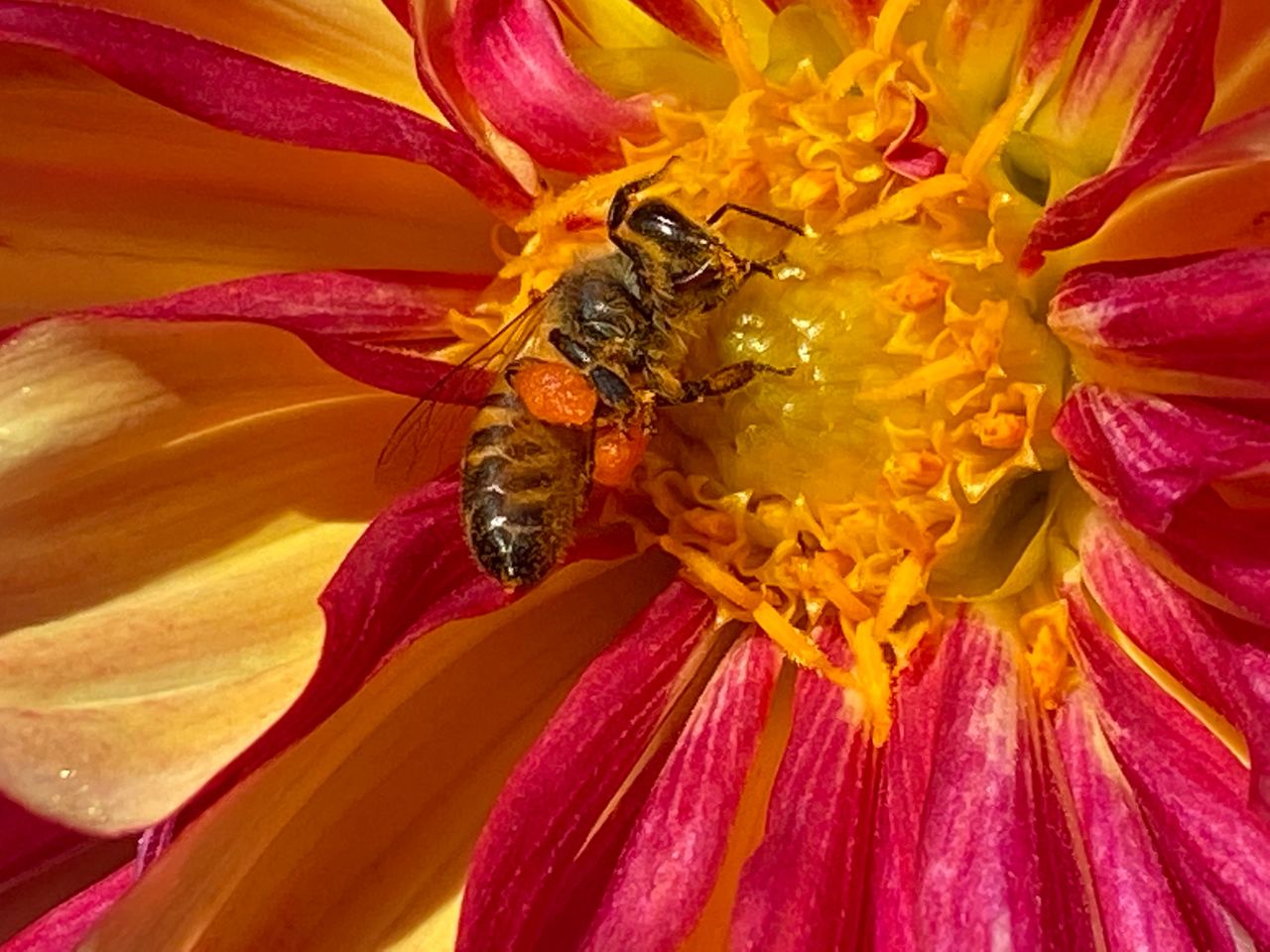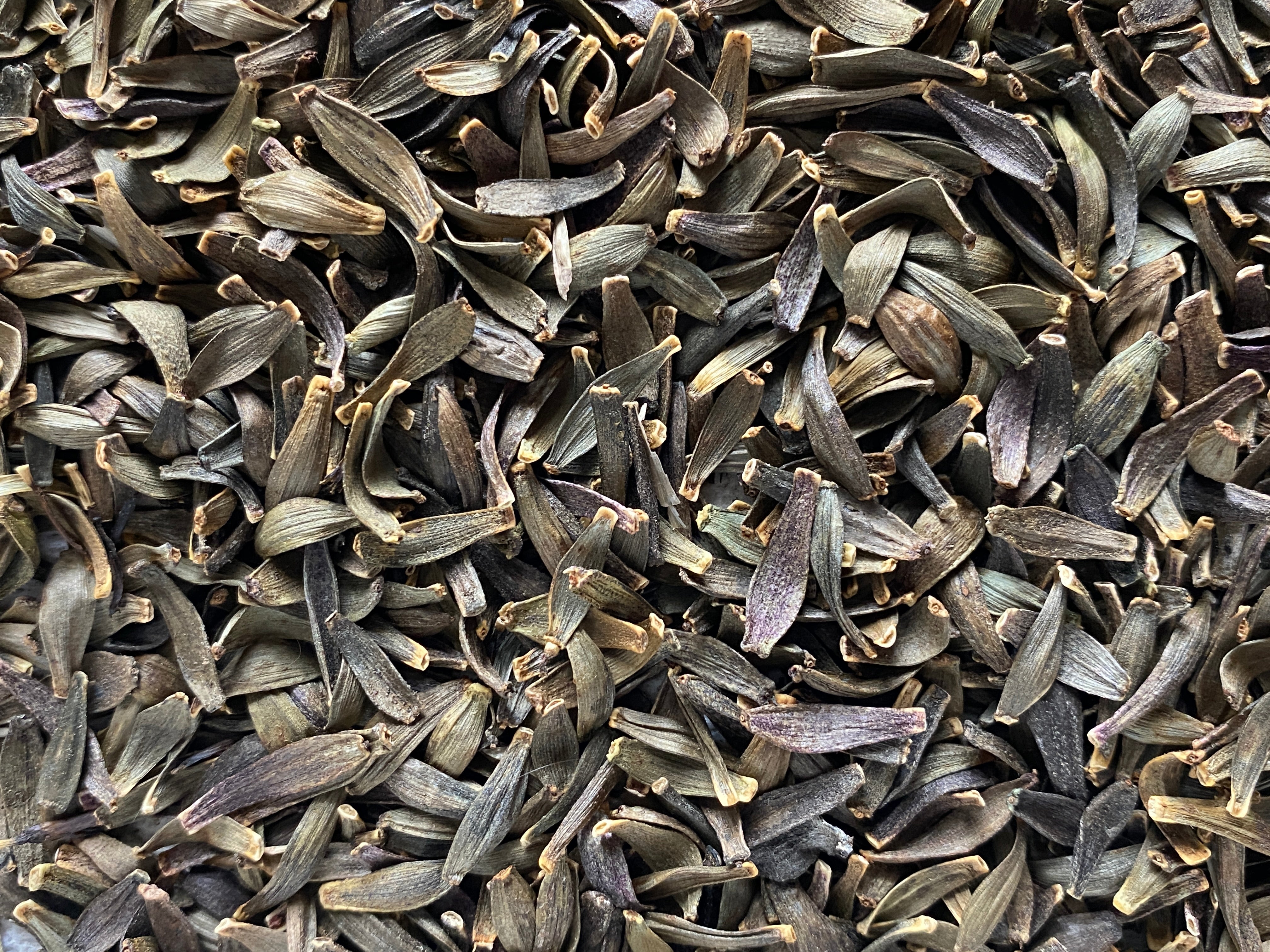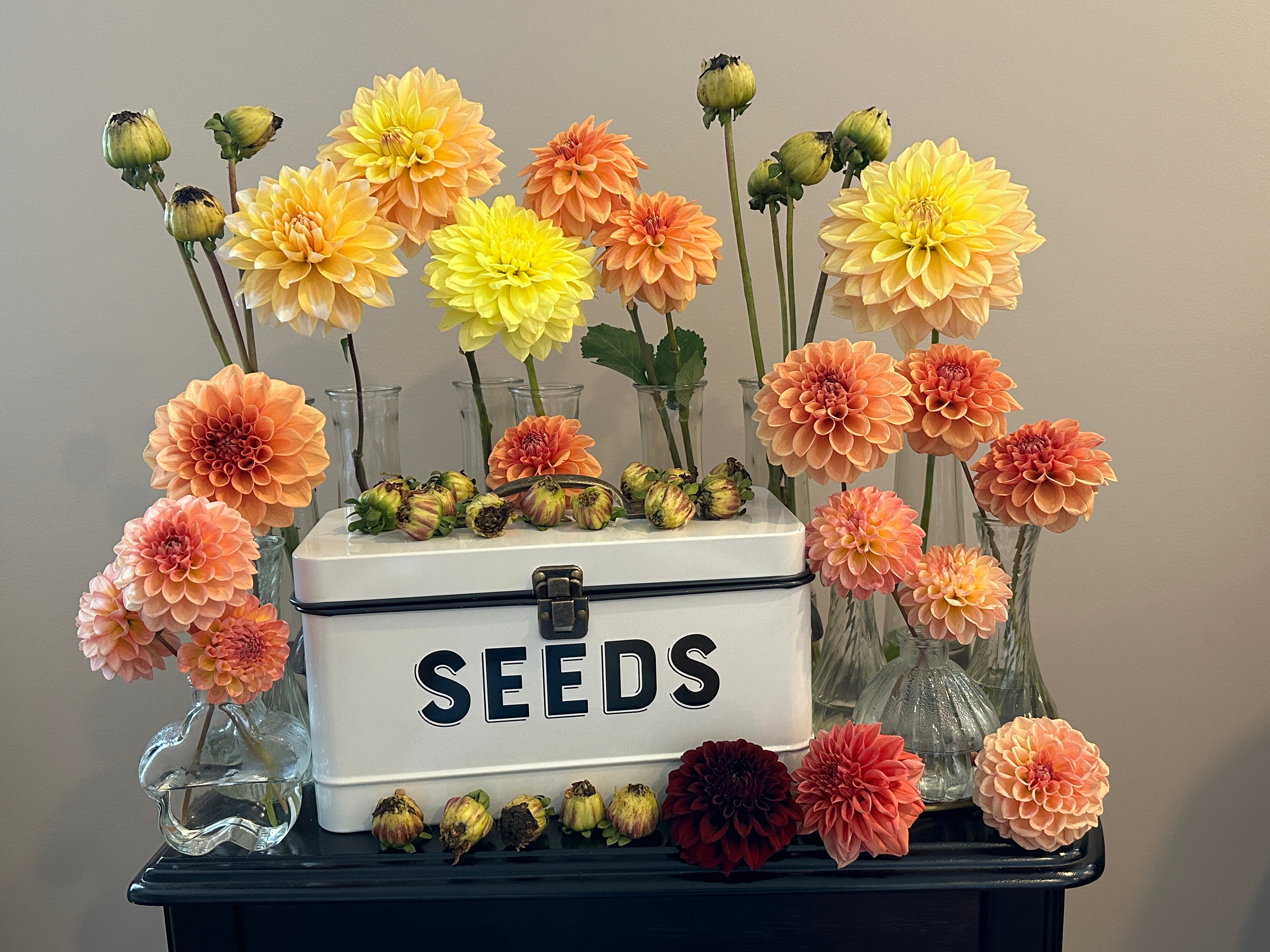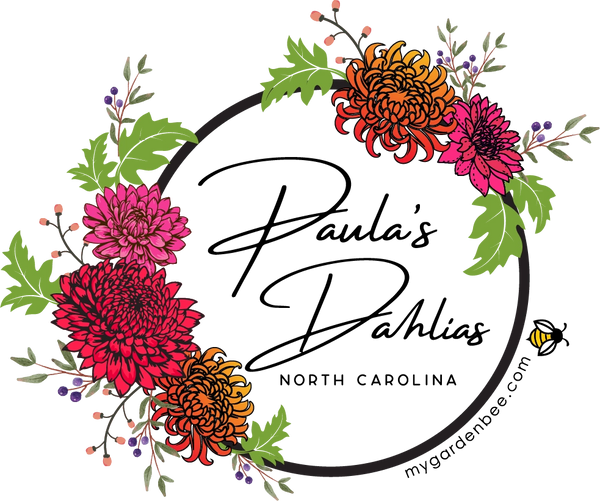
Dahlia Hybridizing. Growing Dahlias From Seed.
Who would think you can hybridize new dahlia varieties from seed. Dahlias are octoploids which means they have eight sets of chromosomes. This is four times the number of chromosome pairs that other plants have so growing dahlias from seeds is so interesting as you do not know what color or form you may receive from a dahlia seed. Most dahlias are grown from a tuber and will look identical to the parent. Some growers take dahlia cuttings to increase the number of plants they have and those cuttings will also be identical to the original tuber. Hybridizing dahlias and growing dahlias from seed is different.

Once I learned that planting dahlia seeds were how dahlia breeders created new varieties, the interest in dahlia seed collecting started. I started leaving some dahlia blooms in September to go to seed. Dahlia seeds are different as they are not clones of the parent dahlia plants. Each seed is unique and can create a dahlia variety that has never existed.
Dahlias originated from Mexico and started out as a single flower. Dahlias are in the Asteraceae family. The petals of the dahlia are important because they help attract pollinators. The center of a dahlia bloom is usually the more fertile part of the dahlia flower.

If disc florets in the center of the bloom are pollinated they can produce a seed. Bees are one of the most efficient pollinators. Bees do prefer open center blooms as they are easy to access the pollen.

A fully double bloom does not show its center as much and can be difficult for the pollinator to access. I try to pick off just a few petals near the center once it has begun showing pollen so the bees can access the pollen.

When you look at the dahlia bloom center, you can study all the parts. The pistil is the female part of the flower and consists of a stigma, style, and ovary. The stigma is the head of the pistil, the style is the stalk, and the ovary is the base of the pistil. The stigma receives the pollen and it travels down the style (pollen tube) to the ovary awaiting fertilization. At the base of the ovary is where the seed will form after pollination.

The stamen is the male part of the flower. The anther is the top of the stamen and the filament is the stalk. The anther is responsible for the production of the pollen. Hopefully, the pollen will be transported to the pistil (female) by pollinators. As the stigma (top of the pistil) matures, the stigma will open making a Y shape where the hairs will catch the pollen. When pollen lands on the stigma, it can go down the tube to the ovary at the bottom and complete fertilization.

All dahlias have both male and female reproductive parts. This process of fertilization occurs over several days. The center of the dahlia holding the pollen opens one set of anthers (the very top of the stamen) at a time and goes around the outer part of the center of the bloom. Once I started watching the bees and studying the center of the bloom, I could see the Y shape on the yellow stigma. I watched the bees land on the dahlia bloom starting at one point and go along the edge of the center and make a complete circle around the outside edge as the anthers have opened.
A lot of dahlia breeders do hand pollination. With hand pollination, you pick the seed parent and the pollen parent. If you are going to try hand pollination, you would need to cover the bloom of the seed parent and the pollen parent so that the bees could not get to the pollen. You would use a small paint brush to bring the pollen from the pollen parent to the seed parent. Again, you would need to keep the blooms away from the bees by putting an organza bag over the blooms so that the bees would not bring in unwanted pollen. I may try hand pollination one year.
There are so many variables such as temperature and weather. Not all the ovaries will be fertilized. Some dahlias are not good at making seed also. Bees tend to visit open centered blooms so with open pollination you may have more seeds that produce open center dahlia varieties instead of fully double blooms. If you want your seeds to produce fully double blooms, then you would want to only grow fully double dahlia varieties.

I was amazed at how many dahlia varieties produced seed in my cut flower field last summer. I let the bees and other insects pollinate the blooms. Bees are very efficient so you will receive more seeds with open pollination.

A good seed parent is going to make a lot of dahlia seeds and a good pollen parent is going to make a lot of pollen. As you let your dahlias go to seed in the fall, you will have to look at what varieties tend to make seed heads and which ones tend to just make pollen.

I have read where wet pollen is not viable. If you are having a lot of rain in the fall, you may have seed heads with a few seeds. Once the petals have fallen from off, you can see it starts to make a cone shape. The seed head closes and becomes a grassy green color with the tip turning black.

It takes around 4 weeks or more for the seeds inside the seed head to mature. I have cover the seed head to protect it from heavy rains. If there is too much moisture in the seed head, the seeds could rot. I do gently squeeze the seed head to remove excess water.

It is so interesting to watch the whole process and to watch the bees and butterflies. I have watched honey bees, bumblebees, sweat bees, flies, and butterflies visit the same bloom.

In my hardiness zone 7 garden, the bee activity really picks up in September. By October, the dahlia field is buzzing with so much activity. I can hardly do anything else but watch the pollinators and take pictures.
The pollinators know that soon cool weather is coming and the frost will kill the blooms. They are trying to collect as much pollen as possible for winter storage or so the butterflies can make it to their southern location in the winter
You want to try to collect your dahlia seed pods before frost. I have collected seed pods after light frosts. You can peel back a little of the pod to see if the seeds are brown or black. If they are green, they are not mature yet. If cold weather or a lot of rain is coming and the seed pods are close to maturity, you can cut the stem holding the seed head.

You want to cut off seed head leaving at least 6" or more of the stem. You will need to label your seed pods so you know who the seed parent is. If you did do some hand pollination, you would want to list both parents.

If the seed pods are not quite ready, you can leave them on a table with a room with good air flow or maybe a fan in the room. You can also put them in a bucket or vase, with the seed heads at the top so they can get air flow and continue to mature and dry out.

You could put them in paper bags or plastic baggies with the labeling tag inside. Just make sure they can continue to dry and not get moldy. Some people hang the seed pods upside down for a month or so and let them dry that way. You will need to see what works for you as you do not want the seeds to mold or rot inside the seed head.

Once you think the seed pod is ready, you can break open the pod. You will see a lot of papery chaff. You are looking for firm dark seeds so you will need to separate the papery chaff from the seeds. If you see light green or very thin seeds, they are not viable. You are looking for plump seeds that are firm and solid. They should not be soft and bendable. I put the seeds on a paper towel with the seed parent name written down on the paper towel. I line up all the seeds on a table and let them dry for several days.
If you did hand pollination, you may only collect up to 15 or so seeds in a seed head. If you let the bees do the pollination, you could have as many as 50 seeds or more from one seed pod. After the seeds are totally dry, I put them in paper coin envelopes. I purchased them on Amazon. I count the seeds and write down that number on the paper coin envelope. I also write down the date so I know how old the seeds are in the future. I write down that it was open pollination and the name of the seed parent. I store all my seed envelopes in a little box that I keep in my house in a spare room where it is cool and dry.

There are millions of different combinations that can come from a dahlia seed. Each seed head can produce 1 to 50 seeds or more and each seed is genetically different.
I look forward to the spring time when I can start germinating the seeds that I collected.
 I normally start germinating my dahlia seeds about 6 to 8 weeks before I plan to plant them outside. These dahlia seedlings will bloom and produce tubers in the fall just like a dahlia planted from a tuber. After they bloom, you will need to decide if you want to keep this dahlia for another year. You should make notes and label the ones you want to keep. Dahlias need 120 days to make tubers so once they have been in the ground for 4 to 5 months, you would dig up the tubers and store them over the winter so you can enjoy those blooms again the following year. I normally wait until at least 5 months before I dig up my tubers in my plant hardiness zone 7 garden.
I normally start germinating my dahlia seeds about 6 to 8 weeks before I plan to plant them outside. These dahlia seedlings will bloom and produce tubers in the fall just like a dahlia planted from a tuber. After they bloom, you will need to decide if you want to keep this dahlia for another year. You should make notes and label the ones you want to keep. Dahlias need 120 days to make tubers so once they have been in the ground for 4 to 5 months, you would dig up the tubers and store them over the winter so you can enjoy those blooms again the following year. I normally wait until at least 5 months before I dig up my tubers in my plant hardiness zone 7 garden.
During the first and second year of studying a new dahlia seedling you are looking at the form, health of the plant, stem, and bloom position. This is important if you are thinking about showing your dahlia at a state fair or a dahlia show.

You may want to keep your dahlia each year because it is a nice garden variety for you to share with your family and friends. You may be interested in dahlia breeding because you would like to sell your own dahlias as cut flowers. Again, it is important to keep some notes about the growing habit of your new dahlia. It would be good to note the good and bad traits of the new variety. Is the color of the bloom consistent? Are the stems sturdy and straight. Is the color of the bloom bright or does it fade in the sunshine? Does the plant produce nice long stems for cutting? What size blooms does the plant produce? When did the plant produce its first bloom? Is it an early bloomer or late bloomer? These are just some of the questions you may want to ask yourself. I always take a notebook and a tape measure out to my dahlia garden to write down any notes. I always take a lot pictures.

I am always surprised at the number of seeds I collect each year. I cannot wait for spring to see how many will germinate. They have been stored all winter in paper coin envelopes in a little plastic tub in my spare room. The germination rate for fully double dahlias can be between 50% to 80%.
I will continue to let the wind and insects carry the pollen from one plant to another. I do remove any single or open centered dahlia. I only want my fully double dahlias blooming when the bees are pollinating blooms. Each seed is going to be unique. A good seed parent is one that produces strong plants with long stems with excellent blossom attachment, consistent color, and is a decent tuber producer. It is so much fun growing dahlias from seed since you do not know what kind of blooms you will have as they can be very different from the parent plant.

One of the best ways to gain knowledge about dahlia forms and breeding is to join your local dahlia society, read as much as you can about dahlias, and try to attend American Dahlia Society judging meetings. Being knowledgeable in judging dahlia varieties helps me to judge my own seedlings. It is important to keep accurate records and document your seedling’s strengths and weaknesses. This is going to help you decide whether the dahlia is worth keeping.
As I lay out my field layout, I am always thinking about which dahlias will make excellent seed or pollen parents. I try to plant dahlias that I want the bees to pollinate next to each other. The possibilities of bloom size, color, and form are unpredictable as I am letting the bees do most of the pollination. It is exciting to go into your dahlia garden in the summertime and see the new dahlia blooms that have never existed before! I hope you try growing dahlias from seed!
